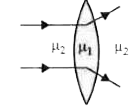A double convex lens of refractive index m1 is immersed in a liquid of refractive index m2. This lens will act as:
diverging lens If m1>m2
diverging lens if m1<m2
converging lens if m1=m2
converging lens if m1<m2
The correct Answer is:B
To determine whether a double convex lens will act as a converging or diverging lens when immersed in a liquid, we can analyze the relationship between the refractive indices of the lens and the surrounding medium.
1. Understanding the Lens and Medium:
- A double convex lens is a lens that is thicker in the middle than at the edges. It is typically a converging lens when in air (or vacuum) because it brings parallel rays of light to a focus.
2. Refractive Indices:
- Let the refractive index of the lens be m1 and the refractive index of the surrounding liquid be m2.
3. Focal Length Formula:
- The focal length f of the lens in a medium can be determined using the formula:
1f=(m1−m2)(1R1−1R2)
- Here, R1 and R2 are the radii of curvature of the lens surfaces.
4. Condition for Converging Lens:
- For the lens to act as a converging lens, the focal length f must be positive. This occurs when:
m1>m2
- This means the refractive index of the lens must be greater than that of the surrounding medium.
5. Condition for Diverging Lens:
- Conversely, if the lens acts as a diverging lens, the focal length f will be negative. This occurs when:
m1<m2
- In this case, the refractive index of the surrounding medium is greater than that of the lens.
6. Conclusion:
- Therefore, the lens will act as a converging lens when m1>m2 and as a diverging lens when m1<m2.
Final Answer:
- The double convex lens will act as a diverging lens if m1<m2.
- A double convex lens is a lens that is thicker in the middle than at the edges. It is typically a converging lens when in air (or vacuum) because it brings parallel rays of light to a focus.
- Let the refractive index of the lens be m1 and the refractive index of the surrounding liquid be m2.
- The focal length f of the lens in a medium can be determined using the formula:
1f=(m1−m2)(1R1−1R2)
- Here, R1 and R2 are the radii of curvature of the lens surfaces.
- For the lens to act as a converging lens, the focal length f must be positive. This occurs when:
m1>m2
- This means the refractive index of the lens must be greater than that of the surrounding medium.
- Conversely, if the lens acts as a diverging lens, the focal length f will be negative. This occurs when:
m1<m2
- In this case, the refractive index of the surrounding medium is greater than that of the lens.
- Therefore, the lens will act as a converging lens when m1>m2 and as a diverging lens when m1<m2.
- The double convex lens will act as a diverging lens if m1<m2.
Similar Questions
Statement-1 : A glass convex lens (refractive index, μ1=1.5), when immersed in a liquid of refractive index μ2=2, functions as a diverging lens.
Statement-2 : The focal length of a lens is given by 1f=(μ−1)(1R1−1R2), where μ is the relative refractive index of the material of the lens with respect to the surrounding medium.
View SolutionA convex lens of refractive index 1.5 is immersed in a liquid of refractive index (i) 1.6 (ii) 1.3 and (iii) 1.5. what changes happens to the focal length of the lens in the three cases ?
View Solution
Knowledge Check
A double convex lens of glass of refraction index μ is immersed in a medium of refractive index μ1. If a parallel beam emerges undeviated through the lens, then
Aμ=μ1Bμ=1μ1Cμ>μ1Dμ<μ1A convex lens made up of material of refractive index μ1, is immersed in a medium of refractive index μ2 as shown in the figure. The relation between μ1 and μ2 is
 Aμ1<μ2Bμ1>μ2Cμ1=μ2Dμ1=√μ2
Aμ1<μ2Bμ1>μ2Cμ1=μ2Dμ1=√μ2When a lens of power P (in air) made of material of refractive index μ is immersed in liquid of refractive index μ0 Then the power of lens is:
Aμ−1μ−μ0PBμ−μ0μ−1PCμ−μ0μ−1. Pμ0Dnone of these
A concave lens of refractive index 1.5 is immersed in a medium of refractive index 1.65. What is the nature of the lens ?
View SolutionA concave lens of refractive index 1.5 is immersed in a medium of refractive index 1.65. What is the nature of the lens ?
View SolutionExplain what happens when a convex lens of refractive index 1.2 is immersed in a liquid of refractive index 1.3.
View SolutionExplain what happens when a convex lens of refractive index 1.2 is immersed in a liquid of refractive index 1.3.
View SolutionA bi-convex lens made of glass (refractive index 1.5) is put in a liquid of refractive index 1.7. Its focal length will be :
View Solution
